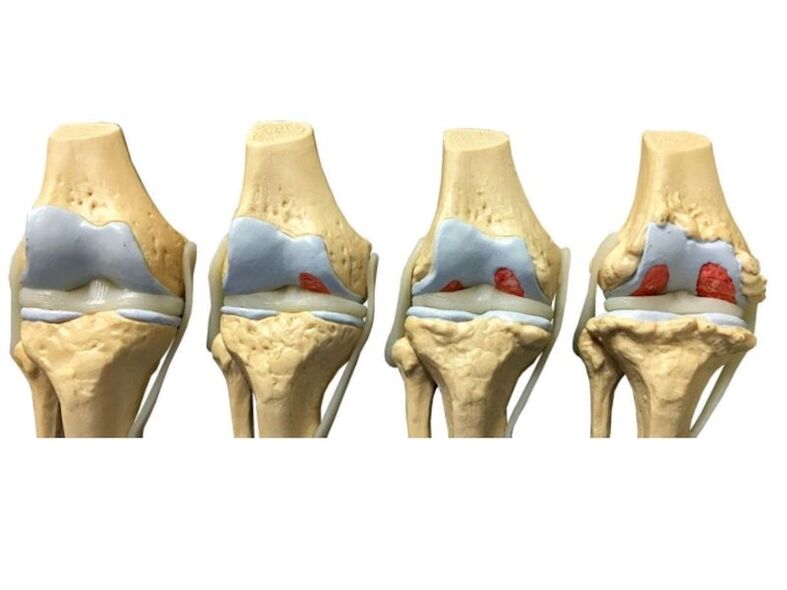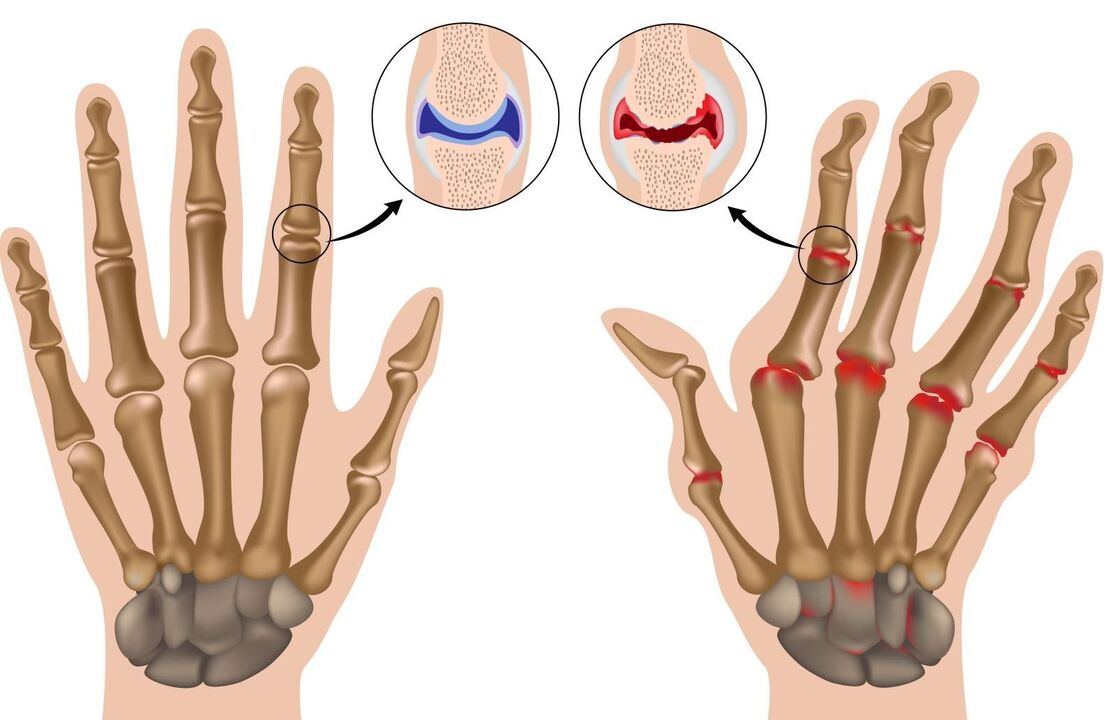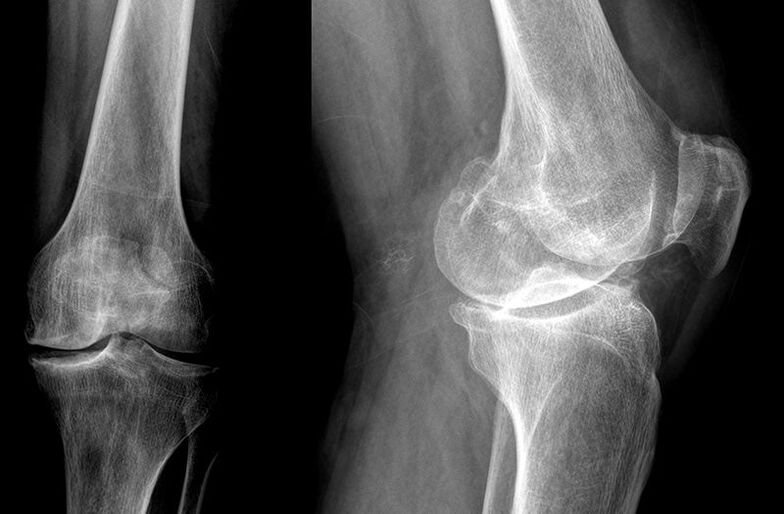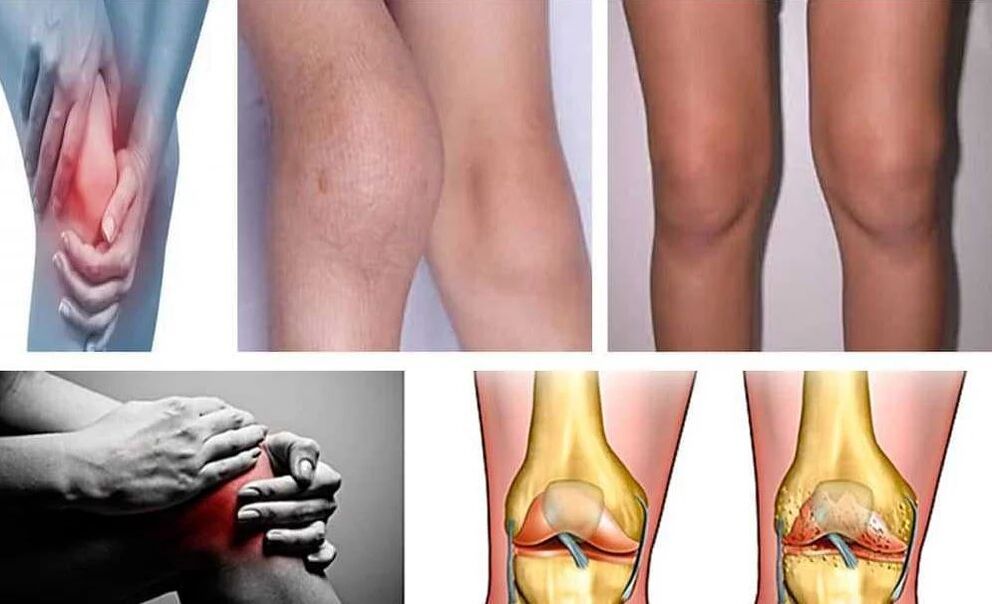Learn what osteoarthritis is and the different types and levels of severity. Learn about the causes and symptoms of osteoarthritis, as well as methods to treat and prevent it.
Osteoarthritis is a common disease of the musculoskeletal system that is associated with disorders of the structure and function of the joints. The disease is chronic and usually develops gradually; their manifestations increase with age. Osteoarthritis can be diagnosed by various signs, such as: E. g. pain, restricted mobility, joint deformities, etc.
Osteoarthritis can occur in any joint, but large joints are most commonly affected: knee, hip, shoulder, elbow. Depending on which joint is affected, the disease can be divided into several types. For example, there is arthrosis of the jaw and facial area, arthrosis of the fingers, arthrosis of the spine and many others.
Each type of osteoarthritis has its own characteristics, but a common feature is loss of joint function, which can cause significant disruption in the patient's life. In order to avoid serious consequences, it is important to consult a specialist at the first signs of the disease and start treatment in a timely manner, which can be either medical or surgical.
Osteoarthritis: degrees and types of the disease
Degree of osteoarthritis
Osteoarthritis is a disease that develops gradually and can go through several stages. The degree of arthrosis depends on how badly the joints are affected and what changes have occurred in them. There are usually three degrees of osteoarthritis.
- First degree– At this stage of the disease, the patient may only experience mild joint pain after physical activity or staying in one position for a long time. Noise loss can also occur when moving the joints.
- Second degree– In this stage of osteoarthritis, the pain increases especially with movement; swelling and movements of the bone in the joint are also possible.
- Third degree– the most severe stage of arthrosis, in which the pain syndrome becomes unbearable and the joint can no longer fully perform its functions. In this case, immediate medical attention is required.
Types of osteoarthritis
Osteoarthritis can affect a variety of joints, but it most commonly occurs in the knees, hips, elbows, and shoulders. A distinction is made between the following types of osteoarthritis.
- Knee osteoarthritis- This is one of the most common types of osteoarthritis affecting the knee joints. It can occur due to injury or overuse of the joints, as well as hereditary factors.
- Hip osteoarthritisis a lesion of the pelvic and hip joints that often occurs in people over 50 years old or in those with a predisposition to the disease.
- Elbow osteoarthritisis a disease that affects the elbow joint. It usually occurs due to injury or overuse of the joint, as well as repeated minor injuries that cause microtrauma to the joint.
- Shoulder osteoarthritisis a lesion of the shoulder joint that can occur either due to injury or due to various diseases, such as rheumatoid arthritis or juvenile arthritis.
In any case, it is necessary to monitor the condition of your joints and consult a doctor at the first signs of disease in order to prevent the development of arthrosis.
Osteoarthritis: concept and causes of development
Osteoarthritis is a disease of the musculoskeletal system that leads to degenerative changes in the cartilage tissue of the joints. The disease is manifested by pain, stiffness of movement and joint deformities, which can lead to impairment of the patient's entire life activities.
The main reason for the development of osteoarthritis is damage to the cartilage, which is responsible for the shock-absorbing function of the joints. Damage can be caused by mechanical damage, increased load on certain areas, impaired blood circulation and tissue nutrition.
The development of osteoarthritis can be influenced by various factors, such as age, heredity, metabolic disorders, obesity, hormonal disorders and mechanical stress in connection with professional or domestic activities.
Types of osteoarthritis:
- Coxarthrosis (damage to the hip joint);
- Gonarthrosis (damage to the knee joint);
- Humeral osteoarthritis (damage to the shoulder joint);
- Radiocarpal osteoarthritis (damage to the carpal-radial joint);
- Interphalangeal arthrosis (damage to the interphalangeal joints of the fingers).
To diagnose arthrosis, radiography, computed tomography, magnetic resonance imaging, and clinical and laboratory examinations are performed. Treatment includes conservative methods (drug therapy, physiotherapy, manual therapy) as well as surgical methods, including joint replacement.
Types of osteoarthritis
Osteoarthritis is a joint disease characterized by the gradual destruction of cartilage tissue. There are different types of osteoarthritis, each of which has its own characteristics and causes.
arthrosis

Osteoarthritis is the most common form of osteoarthritis, which occurs as a result of the body's natural aging and wear and tear on the joints. A characteristic feature of osteoarthritis is the destruction of cartilage tissue, which leads to pain when moving and limited mobility of the joint.
Post-traumatic osteoarthritis

Post-traumatic osteoarthritis occurs as a result of an injury that damages a joint, such as a fracture. Reconstruction of the joint can lead to incomplete restoration of cartilage tissue, which can lead to the development of osteoarthritis.
Rheumatoid osteoarthritis
Rheumatoid osteoarthritis is a systemic disease associated with increased activity of the immune system. In this case, joint inflammation occurs, which leads to the destruction of the cartilage and deformation of the joints.
Summary:There are different types of osteoarthritis, each of which has its own characteristics and causes. Osteoarthritis is the most common form of osteoarthritis, which is associated with the natural aging and wear and tear of the joints. Post-traumatic arthrosis occurs as a result of a joint injury, rheumatoid arthrosis is accompanied by increased activity of the immune system and leads to joint deformation.
How does osteoarthritis occur?
Osteoarthritis is a chronic disease of the joints, which is characterized by dysfunction of the cartilage, the structure and function of the bone and muscle substance. The development of osteoarthritis begins with the gradual wear and tear of the cartilage tissue, which leads to its drying out and loss of elasticity and mobility. This leads to degenerative changes in the joint, which usually lead to severe joint damage.
As the cartilage begins to wear down, its mechanical shock-absorbing function is impaired and pathological contact between the joint segments occurs. Worn bony phalanges become rough and jagged and protrude from the plane of the articular surface. This leads to a disruption in the adhesion of the joint surfaces to each other, which increases the load and creates additional friction, which accelerates cartilage wear.
So, the development of osteoarthritis is associated with the slow progression of cartilage damage, changes in bone tissue, a decrease in synovial fluid and the loss of its oily properties. Typically, osteoarthritis symptoms appear with age, but can also occur as a result of injury or stress to the joint, as well as due to an unhealthy lifestyle that reduces the tissue's ability to repair and maintain normal body functions.
Osteoarthritis: types, degrees, symptoms
What are the symptoms of osteoarthritis?
Osteoarthritis is a chronic disease of the joints that can lead to problems with function and life. This disease can cause a variety of symptoms including:
- Joint pain. This is the most common symptom of osteoarthritis. Typically, pain increases with movement and decreases with rest. It can be sharp or dull and painful.
- Restriction of movement in the joint. With osteoarthritis, the joint may have become stiff and can no longer be moved. For example, the patient may have difficulty bending or extending the knee or elbow.
- Crunching or noise when moving. With osteoarthritis, there may be a grinding or noise in the joints with every movement.
- swelling and redness. In some #1093; Osteoarthritis can cause swelling and redness in the joint. However, this rarely happens.
- joint deformity. If the disease progresses for a long time, chronic deformation of the joint can occur, which is also accompanied by pain and restricted movement.
If you notice such symptoms, you should consult a doctor who will make a diagnosis and prescribe appropriate treatment.
How is osteoarthritis diagnosed?
Basic diagnostic methods
Various methods are used to diagnose osteoarthritis. The most important are:
- Clinical examination of the patient;
- radiography;
- magnetic resonance imaging (MRI);
- Computed tomography (CT);
- Arthroscopy.
Clinical examination
A clinical examination of the patient is carried out by a doctor who examines the joint for pain, swelling, limited mobility and other symptoms of osteoarthritis. In addition, the doctor asks questions about the type of pain, its duration and its manifestations in different situations.
Radiography
Radiography allows you to determine the degree of joint damage and detect characteristic changes that are characteristic of arthrosis. This diagnostic method allows you to determine the reduction in joint spaces, the presence of bone sprouts and joint deformities.
Magnetic resonance imaging
Magnetic resonance imaging (MRI) helps to more accurately determine the type of joint damage and identify other changes that are not accessible to radiography.
CT scan
Computed tomography (CT) is a more accurate method of diagnosing osteoarthritis compared to radiography because it allows you to create a more detailed picture of the joint.
Arthroscopy
During arthroscopy, you can examine the joint using a special instrument - an arthroscope. This diagnostic method allows you to more accurately determine the degree of joint damage and determine the cause of the development of arthrosis.
Treatment of arthrosis: features depending on the degree of development

1st degree osteoarthritis
In the first stage of osteoarthritis development, measures must be taken to preserve the joints and strengthen the muscles. Physical activity and moderate exercise strengthen the muscles and prevent further joint damage. At the same time, you should avoid too much stress and a sedentary lifestyle.
Second degree osteoarthritis
At this stage of arthrosis development, the main task is to relieve pain and prevent further destruction of the joints. In this case, physiotherapeutic procedures, massages, as well as the use of anti-inflammatory drugs and healing ointments can be helpful. It is also recommended to perform regular exercises for joints and muscles.
3rd degree osteoarthritis
In the third stage of osteoarthritis, there is significant destruction of the joint surface, which can lead to serious restrictions on movement. In this case, surgery is often prescribed to repair the joint and restore its functionality. To restore joint function after surgery, rehabilitation treatments, including physical therapy and rehabilitation exercises, are also required.
Basic methods for preventing osteoarthritis
Maintain a normal body weight
Excessive body weight negatively affects the condition of the joints, especially those joints that are subject to greater stress. When it comes to osteoarthritis, being overweight is one of the main risk factors for the development of the disease. The greater the weight, the more force is exerted on the joints and the faster the degenerative process in the cartilage tissue progresses. To prevent the development of osteoarthritis, it is necessary to control weight as much as possible and avoid excessive weight gain.
Do sports regularly
Weak muscles and especially weak joint muscles are risk factors for osteoarthritis. Regular exercises to strengthen the body and joint muscles help prevent the development of osteoarthritis. It should be noted that excessive stress on the joints can negatively affect the condition of the cartilage. Therefore, it is necessary to choose exercises that do not cause significant stress on the joints, but at the same time help to strengthen the muscles.
Choose the right shoes
Shoes, especially those you wear regularly, can have a significant impact on the health of your joints. Avoid wearing high heels as these put additional strain on the knee joints and can contribute to the development of osteoarthritis. Also avoid very hard and tight shoes, as this can lead to misalignment of the foot and increased stress on the joints.
Nutritious food
A nutritious and balanced diet is of great importance for maintaining the health of not only the joints but the entire body. If you suffer from osteoarthritis, you should increase your consumption of foods rich in calcium and vitamin D, which help strengthen bones and joints. It is also very important to drink enough water to maintain optimal moisture levels in the cartilage tissue.
Follow the rules of hygiene and prevention of joint injuries
Adhering to hygiene rules and preventing joint injuries will help prevent the development of osteoarthritis. Do not put unnecessary strain on your joints, do not make jerky movements, do not lift heavy loads and use joint protectors when exercising.
Complications of osteoarthritis
Osteoarthritis is a progressive joint disease that can lead to various complications. One of the most serious complications of osteoarthritis is the complete destruction of the joint. Once a joint is completely destroyed, little can be done to restore function and relieve pain.
Further complications of osteoarthritis include restricted movement in the joint and loss of function. In some cases, surgery may be necessary to correct the problem.
Another possible complication of osteoarthritis is the development of an inflammatory process in the joint. This can lead to pain, swelling, and loss of joint function.
Complications of osteoarthritis can be prevented if help is sought when small joint changes begin. To reduce the risk of complications, it is important to monitor your health, maintain a healthy lifestyle, and regularly see a doctor for the prevention and treatment of osteoarthritis.
Osteoarthritis and Disability: What Do You Need to Know?
What is osteoarthritis?
Osteoarthritis is a chronic disease of the musculoskeletal system in which the function of the joints is impaired. Distinctive signs are pain in the joints and their deformation. Osteoarthritis can occur in any joint in the body, but the knee, hip and shoulder joints are most commonly affected.
Types and degrees of osteoarthritis
Depending on which joint is affected, there are different types of osteoarthritis: knee, hip, shoulder, hand, wrist.
The degree of osteoarthritis can vary. Mild osteoarthritis is characterized by mild pain and limited joint deformation. The average degree of arthrosis is characterized by severe deformation of the joint and painful sensations even at rest. Severe osteoarthritis is associated with limited joint mobility and severe pain.
Osteoarthritis and disability
In the case of severe osteoarthritis, when joint mobility is limited and severe pain occurs, you can apply for incapacity for work. The commission makes the decision to assign disability after a medical examination. Each case is considered individually and the decision is made based on the medical indications determined by doctors.
Restrictions in osteoarthritis and disability
Most people who suffer from osteoarthritis have mobility limitations that make normal activities difficult. When classified as disability, such patients may be provided with additional benefits, such as benefits, free medicines and medical services, and the opportunity to apply to social protection organizations.
How do you maintain healthy joints with osteoarthritis?

Osteoarthritis is a chronic disease of the joints that leads to dysfunction and degeneration of cartilage tissue. However, there are ways to maintain healthy joints when you have osteoarthritis.
Maintain a normal weight
Excess weight is the main enemy of the joints. Weight puts additional strain on the joints and accelerates their destruction. Therefore, pay attention to your weight and reduce it if necessary.
Get physical activity

Physical activity is necessary to strengthen muscles and ligaments, thereby reducing stress on joints. However, strong impacts and traumatic stress should be avoided as they can damage the joints.
Pay attention to diet
Nutrition is an important aspect of joint health. Foods rich in calcium and vitamins strengthen bones and joints. However, you need to limit the consumption of fatty, sweet and smoked foods, as they worsen the condition of the joints.
Visit your doctor
It is important to see a doctor regularly and monitor the condition of your joints. There is no cure for osteoarthritis, but its symptoms can be alleviated with treatment and special exercises.
Following these recommendations will help maintain healthy joints with osteoarthritis. It is important to understand that the slightest discomfort in the joints should be taken seriously and measures should be taken to strengthen them.
Question answer:
What is osteoarthritis?
Osteoarthritis is a chronic joint disease characterized by the destruction of cartilage tissue. This leads to deformations and a restriction of joint mobility.
What types of osteoarthritis are there?
There are different types of osteoarthritis, which vary depending on where the joints are affected. For example, coxarthrosis (arthrosis of the hip joint), gonarthrosis (arthrosis of the knee joint), osteoarthrosis (arthrosis of the fingers and toes), cervical arthrosis (arthrosis of the cervical vertebra), etc.
What symptoms are characteristic of osteoarthritis?
The symptoms of osteoarthritis can vary depending on the severity of the disease. The main symptoms are pain and discomfort in the joints, stiffness and limited mobility, grinding and crackling noises when moving the joints, swelling and redness of the joints.
What factors can cause the development of osteoarthritis?
Risk factors that contribute to the development of osteoarthritis can include age, gender, heredity, joint injuries and overuse, obesity, disorders of calcium and vitamin D metabolism, and other diseases such as diabetes and gout.
What treatment methods are used for osteoarthritis?
Various methods can be used to treat osteoarthritis, including drug therapy, exercise and rehabilitation measures, massage and physiotherapy. In some cases, surgery may be required – endoprosthetics or arthroscopy.
What is the life prognosis for people with osteoarthritis?
The life prognosis for people with osteoarthritis depends on the degree of the disease and the timeliness of treatment. If no treatment is given, complications and restrictions in joint mobility are possible. With timely initiation of treatment and adherence to doctor's recommendations, most patients with osteoarthritis can lead a full life and work.
























